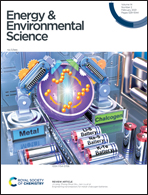Advanced Li metal anode by fluorinated metathesis on conjugated carbon networks†
Abstract
The Li metal anode has high theoretical specific capacity and low redox potential, making it suitable as an anode material for next-generation Li ion-based batteries (LIBs); however, challenges remain due to its unstable solid electrolyte interphase (SEI). In this study, we applied graphene-coated aramid attached to an uncoated aramid separator fabricated using a simple painting method to a Li metal anode to address the issues caused by the unstable SEI via fluorinated metathesis on a conjugated carbon network (CCN). The graphene-coated surface was partially fluorinated in a specific solvent environment, and as the Li+ ions were plated, the fluorinated surface induced formation of LiF as a chemically stable SEI component. Additionally, we demonstrated the successful application of fluorinated metathesis using other CCN materials, such as carbon black and activated carbon. The experimental results indicated that the CCN materials induced LiF via fluorination, and that the negative functionalities and lattice structure of the CCN materials affected the fluorination. These results demonstrated the effectiveness of this novel method for stabilizing a Li metal surface using a graphite pencil.



 Please wait while we load your content...
Please wait while we load your content...